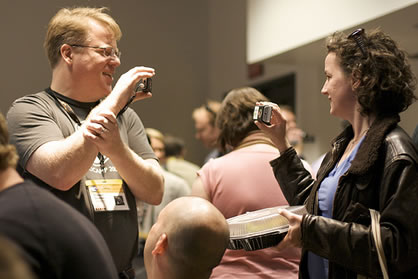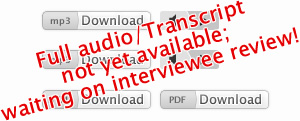
Laura is a consultant that gets almost all her business on Twitter. She builds relationships with senior executives of F500 companies there! Twitter is becoming really important. It’s going to become another level of infrastructure on the Internet, a little like email. I started using it regularly after Laura explained it to me. Twitter is a fascinating service that lets users post short snippets of text from the web and cell phones and IM. Laura shares how she incorporates Twitter into her business and personal life and how it serves as a pipeline for her consulting business. Laura also talks about the various uses of Twitter, and the role it plays in networking between friends and potential clients.
Full Interview Audio and Transcript
Personal Info
Hobbies and Interests: Rock Climbing, Ice Hockey, Yoga, Kids.
Favourite Sports Teams: Boston Red Sox, Hartfort Whalers.
Favourite Books:
- Made to Stick: Why Some Ideas Survive and Others Die by Chip Heath and Dan Heath
Favourite Entrepreneurs: Ev & Biz, Marc Andresson.
Company Website: http://www.pistachioconsulting.com
Fast Track Interview
Adrian Bye: Today I have the pleasure of talking with Laura Fitton, who is also known as Pistachio on Twitter. She actually makes money off of Twitter. Laura, can you tell us a little bit about yourself as well as talk about Twitter?
Laura Fitton: I’m originally from Connecticut and now live in Boston. My company is called Pistachio Consulting. I help people talk less and become more effective with Power Point, speaking, and presenting. It’s a variety of helping them develop their message by consulting, coaching, and team training.
Twitter has completely changed my life, my business, and my community. It has changed how I approach the world and how I make money both on business and personal levels.
On its surface, it’s an SMS-based service where you put out very short messages. It is a comprehensive mix of every communication tool you’ve ever interacted with on the Web: a bulletin board, an IM session, a chat room, and a blog. It is called micro-blogging because you’re putting up these little tiny posts of a 140 characters each.
Everybody is putting up their little series of messages, but those are all interleaved and shared. As a result, you are getting a stream of ideas, information, responses, and updates. You get everything from banal “My cat just rolled over” to “Breaking news, I just saw a train crash” or “Here’s the best article that Mark Hendrison wrote on his blog this week. You guys should all read it.” A tremendous amount of different things are happening, and it is susceptibly powerful.
Adrian Bye: With Twitter, you have the choice of posting your thoughts via the Web, cell phone, or Instant Messaging. Then it can be reviewed on the Web or in other places. What are the primary ways people use Twitter?
Laura Fitton: Everybody is doing it in their own way, and I really see it more as a principle of how communication can work rather than any one specific interface, application, or way to interact.
 On the Web you could be staring at the public stream or at one page of a friend just to catch up on how their last couple of days were before you see them at a meeting. Change the word “friend” to “clients” and suddenly you see one wonderful business value of Twitter. It’s a great way to very loosely and obliquely stay on top of where someone’s life and intellectual curiosities are going.
On the Web you could be staring at the public stream or at one page of a friend just to catch up on how their last couple of days were before you see them at a meeting. Change the word “friend” to “clients” and suddenly you see one wonderful business value of Twitter. It’s a great way to very loosely and obliquely stay on top of where someone’s life and intellectual curiosities are going.
There are a lot of different variables to how you parse the content, how you digest it, and what you do with it. I could go to Pownce, which is a competing service. I could go to Jaiku, but I won’t have the community or different tools I have on Twitter.
Adrian Bye: What are the tools with Twitter that you don’t want to lose?
Laura Fitton: Search is a huge one. Twitter itself has a very limited search. The best search applications are all done third party to find old Tweets, who’s talking about what topics, or who else is at an event with you. The three main search tools are Tweetscan.com, Twittersearch.com, and Terraminds.com.
I also use video blogging tools. One, Qik.com, is a way to shoot live video through my camera and have a chat-back channel. When I’m running that, it is posting links to my account so my followers know I’m doing it.
Twitter has become a publishing platform for me through which I publish video, photos, and audio. I can do spur-of-the-moment interviews with my cell phone through a service called Utterz. I can snap pictures and post them instantly to Twitter. I’ve aggregated my audience there, and I can deliver beyond 140 snippets of text.
Adrian Bye: You have 4,350 followers on Twitter. How much traffic do you actually generate?
Laura Fitton: Obviously, it depends on how good the hook is, how good the context is written, and what time of day it is. While I have 4,350 followers, they’re not all watching at any given time. The average link I post probably gets 20 to 40 clicks. Depending on the strength of the idea, it can easily go up to the hundreds and thousands. I recently had a good idea that had 300 or 400 clicks because a lot of people were picking up the link and retweeting. That is jargon for “I just saw a good idea, something newsworthy, or a moving story, and I’m going to repeat it.” I did have one with 3,200 clicks because it was for a contest with a huge audience, and the link was passed around even more widely. If you have 300 people watching at the time you post and 40 click through, it’s a pretty significant conversion rate.
Adrian Bye: Those are really targeted clicks. What kind of people are you interacting with on Twitter?
Laura Fitton: Whether it’s the flavor of my brand or the way my brain works, I have an extraordinarily high-quality following. The caliber of people on Twitter is very high and focused in the tech 2.0 social world. Twitter has yet to go mainstream to the highest level.
Adrian Bye: Now the interesting thing is that you’re someone who’s actually making money on Twitter. If Twitter went away, how much of your business would be left?
 Laura Fitton: Since I have long-term relationships with a few clients, I’d be okay if it suddenly fell apart tomorrow. However, Twitter is my network, so I would have to build a whole new pipeline. I’d have to struggle to reconnect with all these people who have an awareness of who I am but haven’t necessarily moved down the sales curve toward hiring me. When 3,200 people know who I am and get a feeling for how my mind works, they pretty much call and hire me when they see a project related to what I do. They don’t call and say, “We’re bidding five different companies for this project. Do you want to submit a proposal?”
Laura Fitton: Since I have long-term relationships with a few clients, I’d be okay if it suddenly fell apart tomorrow. However, Twitter is my network, so I would have to build a whole new pipeline. I’d have to struggle to reconnect with all these people who have an awareness of who I am but haven’t necessarily moved down the sales curve toward hiring me. When 3,200 people know who I am and get a feeling for how my mind works, they pretty much call and hire me when they see a project related to what I do. They don’t call and say, “We’re bidding five different companies for this project. Do you want to submit a proposal?”
Another guy on Twitter, Marshall K, writes a blog called ReadWriteWeb. He has been using Twitter to get fresh stories by keeping the right eye on it and getting leads on new breaking news in the space he covers, which is basically social media and web applications. In October, he commented that Twitter was paying his mortgage.
Adrian Bye: How do these deals come about? How do you actually get business off Twitter?
Laura Fitton: It’s the oldest trick in the book. It’s networking. Being known. Being understood. Being liked. Being useful. Being helpful. It is all the things they tell you about getting out there and meeting people.
Adrian Bye: Is it something that can be done as an individual or can it be scaled? In other words, can I have 20 employees generating business on Twitter?
Laura Fitton: It depends on what you’re trying to sell and whether or not it’s really useful to the Twitter community. It can be an inclusive coupon or an exclusive tips service. Jet Blue uses it for airfare specials. Dell uses it when they get a shipment of computers that are going to be returned and refurbished. They can move those computers very quickly because they offer a secret rock-bottom price on Twitter without having to worry about a hundred million people wanting that price.
The appeal is not just the deal but also the surrounding content. Maybe Dell is responding to some questions or Jet Blue is talking about a story of something that happened. It’s not just an incessant stream of coupons.
You can’t push things on people in Twitter because they get to decide if they’re going to listen to you. You need to determine how to generate a revenue stream and a transactional business model in a way that you have something else going on to which people would want to listen. There has to be a reason if you want them to engage. It’s finding ways to be useful and interesting. The secret for success in social media is tying your value proposition to that reason.
Adrian Bye: What qualifies you? Why are you an expert? Who were you before Twitter?
Laura Fitton: Nobody. I obviously had my brain, my way of looking at the world, and my way of shaping ideas, but I did not have any kind of substantial business traction or branding before I was on Twitter.
One of the reasons I’ve gained traction is because I’m mixing the business and the personal. It’s a stream of consciousness, and there’s a fair amount that I share about my personal life and an extraordinary amount I share about just being human with my insights. I don’t try and fake it. I enjoy connecting to people and the thought that some of my random quirky outlooks on life are actually useful to other people.
Adrian Bye: What attracted you to Twitter? Why did you start actively using it?
Laura Fitton: On August 10, I wrote “Ode to Twitter” on my blog and put links to my very first post about Twitter in April of 2007 where I said, “Smart people are using this. This is the stupidest thing I’ve ever heard of.” For the first six weeks, I thought it was the dumbest thing I had ever seen.
In May 2007, I read a fellow called Ben Casnocha, a wonder kid down in the Valley. He started two companies by the age of 19 and is now in college. One day, he blogged that he was using Twitter. I clicked through to his Twitter page, and the last 20 messages were chockfull of books he was reading, meetings he was taking, networking he was doing, and ideas he was having. Something clicked in my brain and said, “Wait a minute. This is the oldest rule in the book as far as business. You surround yourself with successful people.”
 Any business person, who’s just starting to engage in Twitter and doesn’t know what it is yet, needs to listen first before you go in and sell. On a smaller level, use the search tools. Look around to the people you respect and whose ideas you like. Try to find if they’re on Twitter. Follow 10 or 20 people whose Tweets appeal to you because of the business motivations, the ideas, and the inspiration they’re giving you.
Any business person, who’s just starting to engage in Twitter and doesn’t know what it is yet, needs to listen first before you go in and sell. On a smaller level, use the search tools. Look around to the people you respect and whose ideas you like. Try to find if they’re on Twitter. Follow 10 or 20 people whose Tweets appeal to you because of the business motivations, the ideas, and the inspiration they’re giving you.
That was a wonderful way for me to get involved in it because I was getting high quality signal-to-noise ratio on the Tweets by getting a lot of ideas and inspiration. It’s more about intellectual connection, idea sharing, and bringing each other forward. It’s a community. You could build a little community of landscapers on Twitter, and it wouldn’t matter how many people did or didn’t follow them or whether they followed Scoble or Jason Calcanis. All that would matter is that they suddenly have access to the best emerging ideas from each other to run their business better.
Adrian Bye: Is it worth having multiple accounts or is it better to have just one?
Laura Fitton: I have quite a few accounts. I have two for my ordinary use of Twitter, and I have one that was a game I was trying to structure. I have used different IDs to set up a group Twitter to help support a charitable project. I know a lot of people with many different IDs.
Adrian Bye: Let’s say we have a team of 10 guys on Twitter. They’re seeing it during the day so they are all in the loop. Then you could have your public profile where you post your deepest thoughts. Is that accurate for how people are using it today?
Laura Fitton: Yes. It’s a very good idea. Twitter is much more powerful for a small group than a list server or even a Facebook connection because so much happens that is lightweight on the site. You don’t have that annoying person who’s always hitting “reply all” when they really shouldn’t. Everybody on the group chooses what they’re going to bother to consume. Nothing is being forced into anybody’s in-box. It’s lovely and elegant like that, and it scales to the amount of time and attention you’re willing to give it.
Adrian Bye: Are teams actually using that to get their work done during the day now?
Laura Fitton: Yes. My major intellectual interest right now is going into companies, doing some pilot studies, and showing teams how they can use Twitter. It becomes incredibly powerful when you have someone at a remote event rather than waiting for them to return and give their report or follow their daily e-mails or live blog of the event. Instead, they can be flashing URLs back and forth to each other at lightning speed while they stand on the show floor at the booth. They can also ask the vendor or customer with whom they’re talking follow-up questions from their team back home. Things just happen so much faster. It’s very powerful.
Teams also become much more productive when they’re able to keep a finger on the day-to-day of what each other is doing as well as interchange ideas in a much faster cycle rather than waiting for sit-down meetings and formal reports to move the project forward.
Adrian Bye: Can the communications be private?
Laura Fitton: They can be public, or you can choose to protect your updates. You can lose the group aspect and send direct messages, which are one-to-one. In order to do that, you would have each team member set up a profile and select to protect their updates rather than make them public. Then you will have control over who follows you and who can see what. You can also set up group Twitters where it’s like a single blog but many people can post to it. Something like that would be useful in the case of a conference.
Adrian Bye: In closing, is there anything else you would like to tell us?
Laura Fitton: If you go into Twitter or any social network, you need to consider some core things. First, listen intently to get the feel for the community. Don’t just go in with your own agenda. Listen, share, and be part of it. Be useful, nice, and helpful, and it comes back to you in spades.
I invested a lot of time and energy into Twitter because I enjoyed doing it. I never did it because I wanted something out of it. If I had gone in there and said, “I’m going to build a brand on Twitter and become a poster child who is interviewed and has 4,350 followers,” it would have been pretty hard for it to happen. I just went in there with an open mind, listened, and asked lots of questions.










